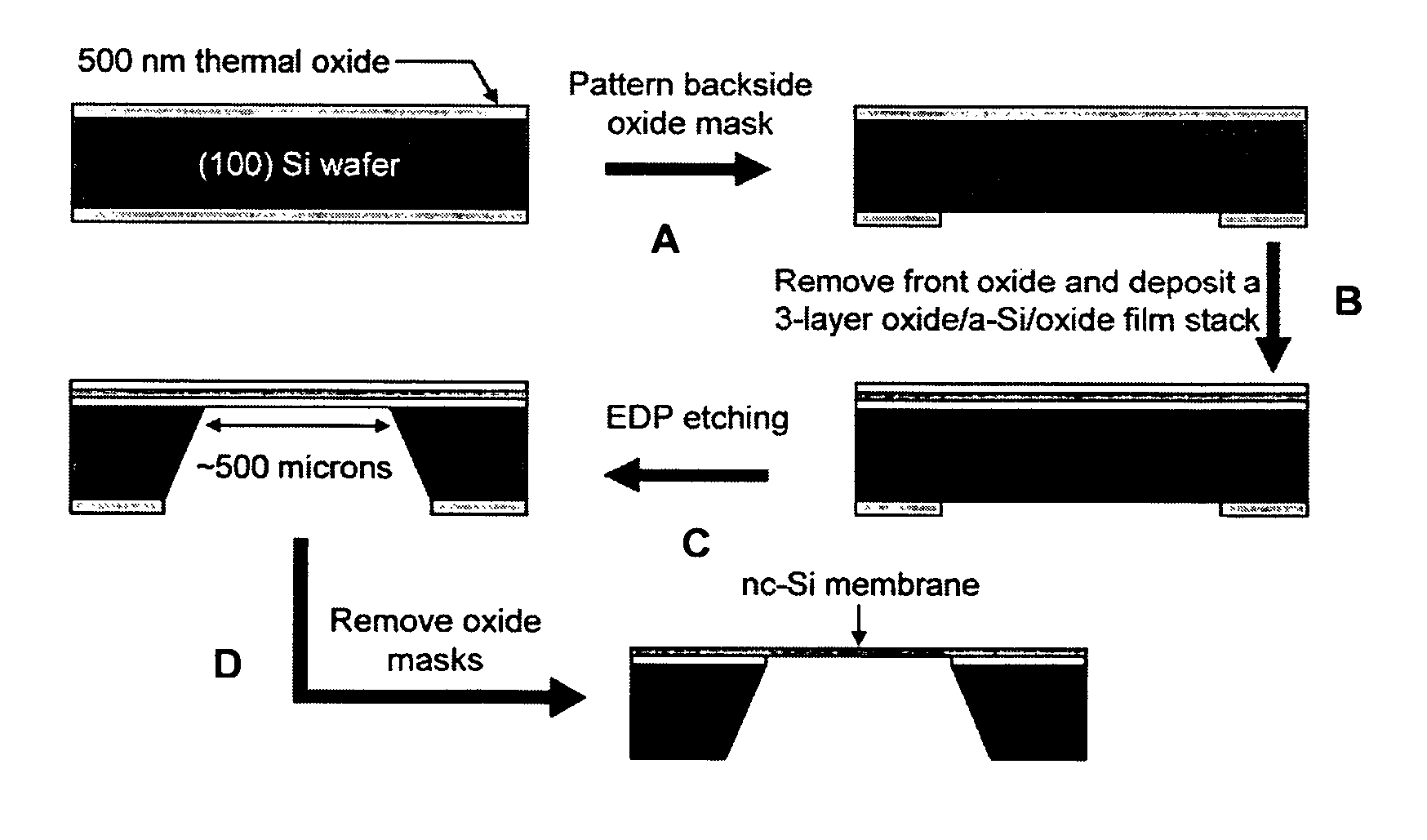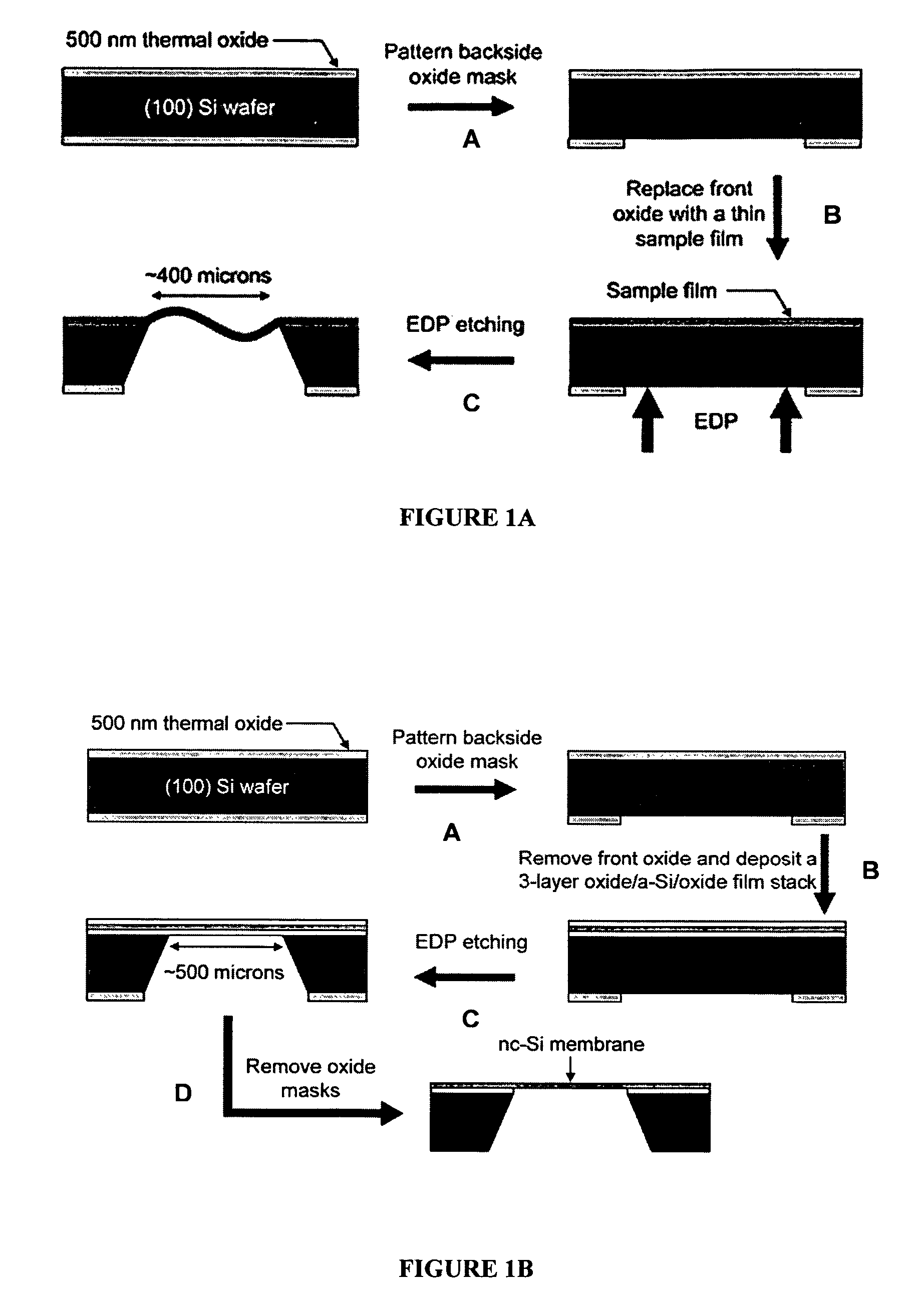Ultrathin nanoscale membranes, methods of making, and uses thereof
a technology of ultrathin nanoscale membranes and nano-scale particles, which is applied in the direction of basic electric elements, electrical equipment, water/sewage treatment, etc., can solve the problems of limiting process design flexibility and no simple alternatives, and achieves the effects of reducing processing requirements, high aspect ratio, and easy patterning and removal
- Summary
- Abstract
- Description
- Claims
- Application Information
AI Technical Summary
Benefits of technology
Problems solved by technology
Method used
Image
Examples
example 1
Formation of Silicon Dioxide Membranes
[0074]After having identified EDP as an anisotropic etchant capable of etching through the bulk of a silicon wafer and stopping abruptly on a thin oxide film, a process had to be engineered for this chemistry. An outline of such a procedure is shown in FIG. 1. This figure illustrates a through-wafer backside etching process graphically. Because SiO2 is so resistant to EDP, a 500 nm thermal oxide is adequate to mask the backside of the wafer (approx 500 microns thick) during the entire duration of the etch. This is quite advantageous since oxide is far easier to deposit, pattern, and remove than SiN, the standard masking layer for through wafer etches with KOH. As indicated in FIG. 1, after the growth of the mask oxide, the backside is patterned. During this patterning process, the front oxide protects the surface from damage induced by handling. The frontside oxide is then removed, and the sample layer of interest is deposited on the front surfa...
example 2
Formation of Nanocirystailine Silicon Membranes
[0078]Nc-Si membranes were fabricated by the procedure outlined in FIG. 1B. A 500 nm thick layer of SiO2 on both sides of a silicon wafer was first grown by placing it in a semiconductor tube furnace at 1000° C. for 2 hours in an ambient of oxygen and steam. On the backside of the wafer, the SiO2 is patterned using standard photolithography techniques to form an etch mask for the membrane formation process. The etch mask for each membrane included a square-shaped opening centrally positioned within a square border (up to 120 masks have been formed on a single silicon wafer). The front oxide layer was then removed by exposing the surface to 4:1 buffered oxide etchant, for 10 minutes in an etching cell similar to that used for EDP etching, and a high quality three layer film stack (20 nm-SiO2 / 15 nm-amorphous silicon / 20 nm-SiO2) was RF magnetron sputter deposited on the front surface. The a-Si layer was sputtered at a chamber pressure of 1...
example 3
Formation of Additional Nanocrystalline Silicon Membrane
[0083]The procedure described in Example 2 was used to form a 7 nm a-Si layer sandwiched between two 20 nm layers of SiO2 using sputter deposition (see FIG. 7B); the silicon was then annealed at 950° C. for 30 sec to form a nc-Si layer. After release, a wrinkled membrane similar to other oxide membranes was formed (FIG. 7A). However, after the removal of the sacrificial SiO2, with a 25 second dip in buffered oxide etch (BOE), an extremely flat 7 nm ne-Si membrane was produced (see FIGS. 7B-C). This dramatic shift from compressive to tensile stress was unexpected, yet is indicative of the volume contraction that occurs when a-Si is crystallized (Miura et al., Appl. Phys. Lett. 60:2746 (1992), Zacharias et al., Journal of Non-Crystalline Solids 227-230:1132 (1998), which are hereby incorporated by reference in their entirety). Since the oxide remains compressively stressed after annealing and is much thicker than the a-Si, the ov...
PUM
| Property | Measurement | Unit |
|---|---|---|
| surface roughness | aaaaa | aaaaa |
| thickness | aaaaa | aaaaa |
| thick | aaaaa | aaaaa |
Abstract
Description
Claims
Application Information
 Login to View More
Login to View More - R&D
- Intellectual Property
- Life Sciences
- Materials
- Tech Scout
- Unparalleled Data Quality
- Higher Quality Content
- 60% Fewer Hallucinations
Browse by: Latest US Patents, China's latest patents, Technical Efficacy Thesaurus, Application Domain, Technology Topic, Popular Technical Reports.
© 2025 PatSnap. All rights reserved.Legal|Privacy policy|Modern Slavery Act Transparency Statement|Sitemap|About US| Contact US: help@patsnap.com



